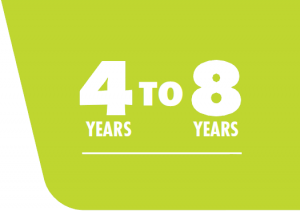Booster Seat
FORWARD FACING CHILD CAR SEATMODELS: CS5413 SERIES II

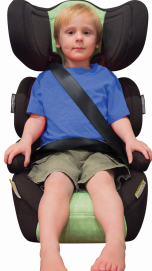
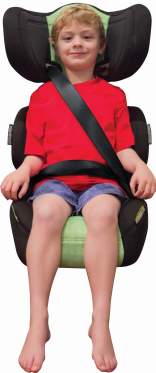
FORWARD FACING(Forward Facing) Suitable for children from approximately 4 years to 8 years* of age.
Instruction Manual
IMPORTANT: KEEP THIS BOOKLET IN THE PLACE PROVIDED ON THE CHILD RESTRAINT
- All references to age are approximates only and reference to children of average proportions. Children vary in shapes and sizes. The photo displayed is indicative of the type of restraint and may vary slightly depending on the model.
Please read carefully the whole of the instructions for installation and, in the event of doubt about the method of installation, to consult InfaSecure or agent, or a child restraint fitter, or in New Zealand, to consult the agent for the vehicle.
Information
This instruction manual covers various models under the Model number CS5413 SERIES II. This Booster Seat is designed to be used by children from approximately 4 years of age up to approximately 8 years of age. This booster seat is installed in the rear of the car, forward-facing using the vehicle seat belts & top tether strap.
Air Cocoon Technology™️ – A Protective Embrace Air Cocoon TechnologyTM (A.C.T.) enhances protection by dramatically reducing the impact forces during a crash. A.C.T. utilises a layer of air held inside the entirety of the child restraint shell, offering an increased level of protection across the entire surface area of the restraint. Your child is quite literally cradled in a cocoon of air, offering a true 180 degrees of protection to your child’s vital organs.
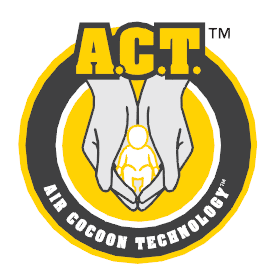
Air Cocoon TechnologyTM integrated child restraints start their life as an actual pillow of air. This pillow is moulded into a child restraint, retaining the pillow-like construction while adding incredible strength and structural integrity. This manufacturing process is called blow-moulding.
Air Cocoon TechnologyTM (A.C.T.) is an all encompassing protective `cocoon’ around your child.
Child Restraints
No child restraint can guarantee absolute protection from injury in every crash. However, to ensure that your child gets all the protection designed into the restraint please read and follow the instructions exactly and use only InfaSecure recommended parts and accessories.
Family Bussiness
InfaSecure is an Australian owned and operated family business, which can trace it’s roots back over 60 years, becoming the single largest Australian owned and operated child restraint company in the country. Today, we are still growing, continuing to innovate and provide high quality products at an affordable price.
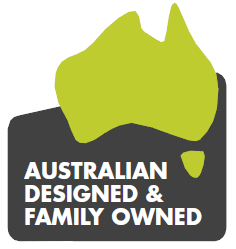
Warnings
![]() WARNINGS
WARNINGS
- Use the restraint exactly as shown in the instructions.
- Supervision of children is needed because they may be able to undo buckles.
- DO NOT LEAVE CHILDREN UNATTENDED IN THE CAR.
- Do not alter or modify this restraint.
- Repairs must only be done by the manufacturers or agent.
- Do not allow the restraint to come into contact with polishes, oils, bleach and otherchemicals.
- Destroy the restraint if it has been in a severe crash, even if no damage is visible.
- DO NOT USE THIS RESTRAINT WITHOUT THE COVER.
- Always secure the loose end of the top tether strap. Do not use the child restraint wherethis strap may fall into a split in the seat back or off the side of the seat.
- ALWAYS ATTACH HOOK AND REMOVE SLACK.
- DO NOT USE WITH JUST A LAP BELT. You must use with a lap-sash belt.
- The lap part of the seat belt must be firmly across the thighs and the sash belt fitteddiagonally across the chest and on the shoulder.
Warnings
![]() WARNINGS
WARNINGS
- THIS RESTRAINT IS NOT SUITABLE FOR USE WHERE THE TOP TETHER STRAP MAY FALL INTO A SPLIT IN THE SEAT BACK OR OFF THE SIDE OF THE SEAT.
- THIS RESTRAINT MUST BE ATTACHED TO A CHILD RESTRAINT UPPER ANCHORAGE POINT IN THE CAR. REFER TO CAR OWNER’S HANDBOOK FOR LOCATION OF ANCHORAGE POINTS. REFER TO A CHILD RESTRAINT FITTING STATION IF NO ANCHORAGE POINTS ARE IN THE MOTOR CAR.
- Always secure the loose end of the top tether strap to prevent it hanging out of the car or being accessible by the child.
- Do not use the child restraint where this strap may fall into a split into the seat back or off the side of the seat.
- IF AN AIRBAG IS FITTED IN THE SEATING POSITION WHERE THE CHILD RESTRAINT IS TO BE FITTED, FOLLOW THE VEHICLE MANUFACTURER’S WARNINGS AND INSTRUCTIONS.
![]()
![]()
![]()
Restraint Guide










IMPORTANT: Research has shown that the likelihood of an accessory child safety harness being used incorrectly is very high and the risk of injuries when incorrectly used is much higher compared to a lap-sash seat belt. InfaSecure recommend that an accessory child safety harness should only be used if a lap-only seat belt is all that is available.
Booster Seat (Forward Facing) – Booster Car Seat
THE SUITABILITY OF THE CHILD RESTRAINT TO GROUPS OF CHILDREN
TYPE E To be used with a lap-sash seatbelt by a child whose shoulders are above the lower shoulder height marker (approximately 4 years of age) until the child’s shoulders reach the upper shoulder height marker (approximately 6 to 8 years of age).
Continue to use this booster seat until the child reaches this limit. Children are safest in a booster seat until their shoulders reach the upper shoulder height marker of the booster seat.
Do not use this booster seat until child’s shoulders are above the lower shoulder height marker.
If the knees do not bend in front of the vehicle seat cushion continue to use a booster seat.
Just using a seatbelt is not recommended for children that have outgrown this seat. Use a larger booster seat.
THIS RESTRAINT MUST BE USED IN CARS WITH FORWARD-FACING SEATS WITH A LAP-SASH SEATBELT. THIS BOOSTER SEAT IS NOT SUITABLE FOR USE WITH A CHILD HARNESS.
The use of child restraints in the front seat may be restricted for children of specific ages by local legislation. Please check with your local Department of Transport for the specific seating locations of children using child restraints for their given ages.
![]()
![]()
![]()
![]()
![]()
![]()
![]()
![]()
![]()
![]()
![]()
![]()
![]()
- For a vehicle without a fixed parcel shelf an extension strap(s) may be needed. If so ring (02) 4728 8080 for nearest supply location.
- Seatbelt extenders are not recommended to be used if the seatbelt is not long enough to secure the child restraint. If seatbelts are too short then advice should be sought from a child restraint fitter and their recommendation be considered before using a seatbelt extender.
![]()
![]()
![]()
![]()
![]()
![]()
![]()
![]()
![]()
![]()
![]()
![]()
![]()
Booster Car SeatShoulder Height Markers
Smaller ChildShoulder height markers are provided on this restraint for a visual indication that the child is safe to travel in this restraint.


Smaller Child from approximately 4 years of ageDo not use this booster seat if the child’s shoulders are below the lower shoulder height marker, (Lower label)
SHOULDERS BELOW THIS LINE WHEN
LOWER LABEL
HEADREST AT HIGHEST POSITION SHOULDERS ABOVE THIS LINE WHENHEADREST AT LOWEST POSITION
![]()
![]()
![]()
![]()
![]()
![]()
![]()
![]()
![]()
![]()
![]()
![]()
![]()
Booster Car Seat – Shoulder Height Markers
Taller ChildShoulder height markers are provided on this restraint for a visual indication that the child is safe to travel in this restraint.


Continue to use this booster seat until the child’s shoulders reach the upper shoulder height marker, (Upper Label).
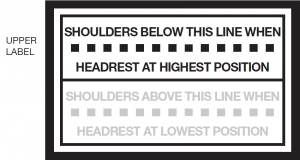

If the child’s shoulders reach the shoulder height markers, the child should move to the next type of restraint.
Model CS5413 Booster Car Seat


- Adjustable Headrest
- Shoulder Height Markers
- SAFE GRIP Red Belt Clamp (if supplied)
- Vehicle Seat Belt
- “BOOSTER SEAT BELT PATH” Marker (each side of restraint – coloured red)
- Comfort Cover• Headrest• Backrest• Seat Base
- Top Tether Assembly• Tether Strap• Adjuster• Attachment Clip• Anchor Fitting + Attachment Hardware
Next Restraint
Next Type of RestraintRefer to the `RESTRAINT GUIDE’ for the selection for the most appropriate next restraint (refer Page 5). When the child has outgrown the booster seat, then you can use either of the following;
- Vehicle Seat Belt check the “Five Step Test” for suitability.
Five Step TestStep 1: Can the child sit with their back against the vehicle seat back? (refer Figure 1).Step 2: Do the child’s knees bend in front of the edge of the seat? (refer Figure 2).Step 3: Does the sash (shoulder) belt sit across the middle of the shoulder, not on the neck or out near the arm? (refer Figure 3).Step 4: Is the lap belt sitting low across the hips touching the thighs? (refer Figure 4).Step 5: Can the child stay seated like this for the whole trip? (refer Figure 5).
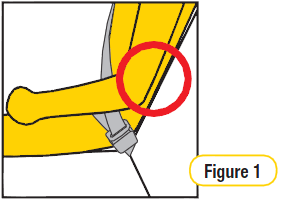



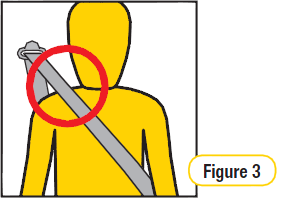





Set Up
Adjusting the HeadrestThe headrest can be adjusted to different heights, to best suit your child’s shoulder height. This can be done with the child in the seat.
Step 1: Grab the headrest, push or pull to move the headrest either up or down.Step 2: Adjust the headrest height so that the bottom of the sash guide is located level with or just above the child’s shoulder.
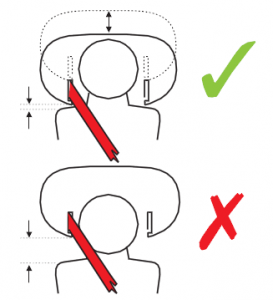

![]()
![]()
![]()
![]()
![]()
![]()
![]()
![]()
![]()
![]()
![]()
![]()
![]()
Installation
Installing in VehicleStep 1: Place the child restraint in the car, in a forward facing seating position (Refer the Figure 1).Step 2: Install the upper anchorage fitting as shown on page 20 & 21 of these instructions.Step 3: Hook the attachment clip to the anchor fitting. Ensure there are no twists in the upper anchorage strap (Refer to Figure 2).




![]()
![]()
![]()
![]()
![]()
![]()
![]()
![]()
![]()
![]()
![]()
![]()
![]()
Installation
Installing in VehicleStep 4: Pull to tighten and remove all the slack, from the top tether strap (refer to Figure 3). Do not over tighten as this could cause the restraint to lift off the vehicle seat.Step 5: Roll up the excess webbing from top tether strap and store in the pocket provided (refer Figure 4).
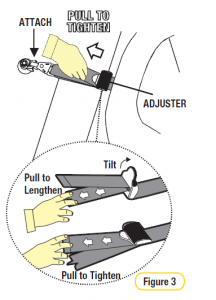

![]()
![]()
![]()
![]()
![]()
![]()
![]()
![]()
![]()
![]()
![]()
![]()
![]()
CAUTION: CHILDREN CAN BE INJURED OR RESTRAINTS AND TOP TETHER STRAP DAMAGED BY UNSECURED CARGO IN A COLLISION. SECURE OR REMOVE HAZARDOUS CARGO BEFORE USING THIS CHILD RESTRAINT.
![]()
![]()
![]()
![]()
![]()
![]()
![]()
![]()
![]()
![]()
![]()
![]()
![]()
- Tighten till slack is removed.
- In certain vehicles an extension strap may be needed.
- Do not overtighten Top Tether strap.
- Ensure Top Tether strap is passed through the Top Tether Strap Guide.
- Always secure the loose end of the top tether strap to prevent it hanging out of the car or being accessible by the child.
Tether StorageAfter correctly installing the restraint in your car, roll up and place any excess tether strap in the storage pocket provided (refer Figure 4).
Use
Using lap-sash seat beltStep 1: Ensure the restraint has been installed as per “INSTALLING IN VEHICLE” (refer Figure 1)Step 2: Sit your child in the restraint with their back against the backrest adjust the headrest as described in setup to best suit your child (refer Figure 2).
![]()
![]()
![]()
![]()
![]()
![]()
![]()
![]()
![]()
![]()
![]()
![]()
![]()
Step 3: Position the lap section of the vehicle seat across the child’s lap then insert the buckle tongue in to the belt buckle until you hear “CLICK”. Ensuring the lap portion is positioned under the armrests and over the child’s thighs (refer Figure 3).The red “Booster Seat belt Path” labels are located each side of the Booster seat and on the head rest.Step 4: Check the position of the headrest and adjust if needed (refer Page 9).Step 5: Thread the sash belt through the sash guide on the bottom of the headrest.


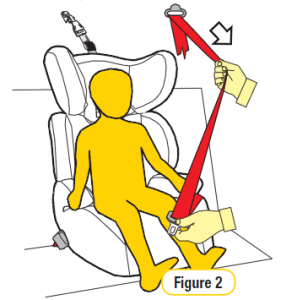

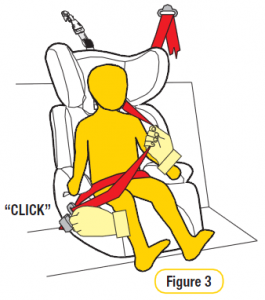

![]()
![]()
![]()
![]()
![]()
![]()
![]()
![]()
![]()
![]()
![]()
![]()
![]()
Use
Using lap-sash seat beltStep 6: Pull the lap belt tight by first pulling on the lap belt in the direction of arrow 1 (refer Figure 4). Pull the sash belt tight in the direction of arrow 2.
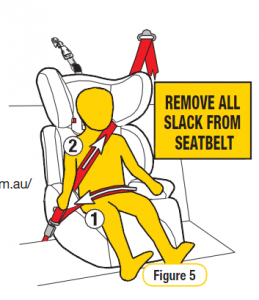

![]()
![]()
![]()
![]()
![]()
![]()
![]()
![]()
![]()
![]()
![]()
![]()
![]()
Safe Grip (if supplied)*Can be purchased separately visit http://store.infasecure.com.au/
SAFE GRIP BELT CLAMPIt is important that the lap belt must be firmly across the thighs. The Safe Grip locks the lap belt to ensure a firm fit across the thighs, and avoids slack in the lap belt. This fit ensures that the lap belt does not ride up into the soft abdominal region of the child, which may cause internal injury.


To install the Safe Grip (red belt clamp);Continue from Step 6: while holding the belts tight open the Safe Grip and clamp the “sash section” of the vehicle seat belt by closing the barrel section of the red belt clamp in the direction of arrow 3 (refer Figure 6) and then locking with the toggle section by pushing in the direction of arrow 4 (refer Figure 6) Note: Positioned as close as possible to the buckle and tongue. When the Safe Grip (red belt clamp) is secured in place, the lap section is now tightly holding your child in place, independent of the sash section. The Safe Grip (red belt clamp) can be left located on the sash belt when the child is removed from the booster. It is then ready for the next use. Repositioning of the Safe Grip (red belt clamp) may be required as the child grows. The Safe Grip (red belt clamp) must be removed when the child restraint is not installed to allow other users to use the seat belt as a lap/sash seat belt. Always keep the Safe Grip (red belt clamp) in pocket provided when not in use.
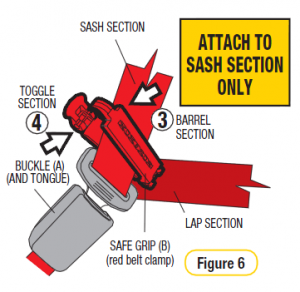

NOTE: Do not place the Safe Grip (red belt clamp) around both the lap and sash sections of the belt. This could cause the Safe Grip (red belt clamp) to break.
Use
Using lap-sash seat beltStep 5: Check the position of the headrest and adjust if needed (refer Page 9).Step 6: Thread the sash belt through the sash guide on the bottom of the headrest.
![]()
![]()
![]()
![]()
![]()
![]()
![]()
![]()
![]()
![]()
![]()
![]()
![]()
- DO NOT LEAVE CHILDREN UNATTENDED IN THE CAR
- ALWAYS USE THE SASH GUIDE
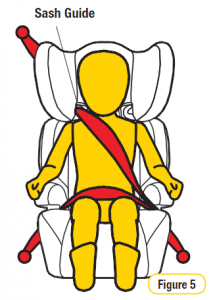

Safety Warning
![]()
![]()
![]()
![]()
![]()
![]()
![]()
![]()
![]()
![]()
![]()
![]()
![]()
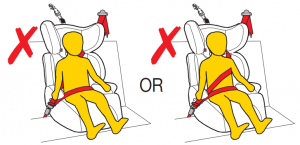

Use
To release childStep 1: To release your child from the restraint simply press the belt buckle and carefully remove your child from the seat. It is not necessary to release the red belt clamp, to remove your childNote: When the restraint is not in use, the seat belt should be fastened around it and engaged.
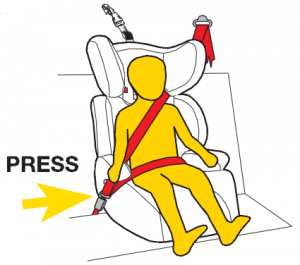

![]()
![]()
Care of Restraint
The child restraint cover has been manufactured to meet the Australian Standards requirements for flammability and toxicity to ensure your child’s safety. The cover has also been designed to provide your child with comfort and support.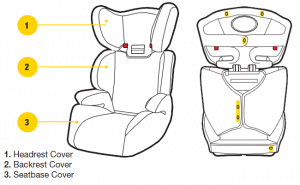

VERY IMPORTANT Only replace the cover with a InfaSecure supplied replacement cover with identical shoulder height markers or a replacement cover meeting AS/NZS 8005.
Care and Maintenance
Regular care of the restraint will ensure safety of your child.
- Check the webbing for fraying.
- Check the upper anchorage attachment clip to ensure retainer clip is still present.
- Ensure there are no cracks in moulding or the plastic moulding.
- Check the buckles “click” when you engage tongues and is not sluggish or stickyin operation.
- Ensure the buckle is free of fluff, liquid, or other matter that may enter the buckleslots. Clean the buckle if it is sluggish to engage (refer Cleaning Harness Buckle Pages 23 & 24).
- Check the harness adjuster is operating and is clamping the webbing
- If any part of the restraint is cracked or broken, seek repair immediately or replace the child restraint.
Care of Restraint
Cleaning![]()
![]()
![]()
![]()
![]()
CoversThe restraint has a ame retardant cover which is removable for cleaning. Cleaning instructions are on the care label attached to the cover. If a uffy cover is fitted, then washing the cover prior to use will remove excess uff. The cover has been designed to protect your child when seated in the restraint. Care should be taken if children either eat or drink while in the restraint as some food or drink products may cause damage or marking to the cover. Wash or clean immediately. Do not pull sticky items from covers as the cover may be damaged – soak in water and gently remove. Only machine wash on gentle cycle (hand washing is recommended). When washing the covers, ensure the hook and loop attachment strips are connected to eliminate other materials or garments being caught. Ensure that the hook and loop attachment strips are free of lint, this will ensure a positive engagement.
SeatUse only mild soap and water to clean all webbing, metal and plastic parts of the restraint using a damp cloth. Do not use chemicals or cleaning agents.
Care and Maintenance(A) Check the webbing for fraying.(B) Check the upper anchorage attachment clip to ensure plastic retainer clip is still present.(C) Ensure there are no crack in the plastic moulding.
Extension Straps
If required contact infasecure for nearest supply location. Extension straps may be required in vehicle without a fixed parcel shelf (not included in this package)
Products Codes CS111 300mm Length CS112 600mm Length CS113 200mm – 900mmAdjustable Length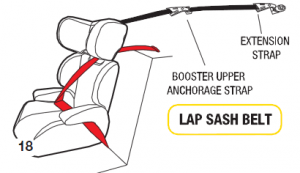

AccessoriesFollow the instructions covering the use of accessories provided with this child restraint or spare parts provided by InfaSecure for this restraint.
![]()
![]()
![]()
![]()
![]()
SEAT PROTECTOR (if fitted)The seat protector is designed to protect your car’s seat.
STANDARDStep 1: Position the front ap with pockets, at the front of the rear seat and position the mat rearwards to obtain a at fit.
FULL LENGTHStep 1: Position the front ap with pockets, at the front of the rear seat and position the mat rearwards to obtain a at fit. (If required an additional ap has been provided to tuck in between the seat back & cushion)Step 2: Position the back section up the seat back and use the plastic buckle & webbing strap to attach around the vehicle seat headrest (if the rear vehicle seat does not have a headrest then the strap could be used to attach around the child seats top tether after you have installed the child seat).


Anchorage Fittings
Some vehicles may have an anchor fitting already fitted by the vehicle manufacturer.If no anchorage points can be found refer to the vehicle manufacturer, or an authorised child restraint fitting station for the best location of an anchorage point.Refer to the vehicle owners handbook or child restraint fitting station for the possible use of spacers.Some vehicles may require the use of additional extension straps (not supplied with this child restraint)If so ring InfaSecure on (Aust) (02) 4728 8090 for nearest supply location. ADDITIONAL EXTENSION STRAPS AVAILABLE: CS111 300mm Extension strap CS112 600mm Extension strap CS113 200 – 900mm Adjustable Extension strap
![]()
![]()
![]()
![]()
![]()
- Top tether strap and attachment clip must always be used
- Always ensure that the upper attachment clip is correctly engaged to the anchor fitting
- THIS RESTRAINT MUST BE ATTACHED TO A CHILD RESTRAINT ANCHORAGE POINT IN THE CAR. REFER TO CAR OWNER’S HANDBOOK FOR LOCATION OF ANCHORAGE POINTS. REFER TO A CHILD RESTRAINT FITTING STATION IF NO CAR ANCHORAGE POINTS ARE IN THE MOTOR CAR.
- THIS RESTRAINT IS NOT SUITABLE FOR USE WHERE TOP TETHER STRAP MAY FALL INTO A SPLIT IN THE SEAT BACK OR OFF THE SIDE OF THE SEAT.
For cars fitted with a child restraint anchorage point
THIS RESTRAINT MUST BE ATTACHED TO A CHILD RESTRAINT ANCHORAGE POINT IN THE CAR. LOCATE THE ANCHORAGE POINT BEHIND THE REAR SEATING POSITION CONSULT THE CAR OWNER’S HANDBOOK FOR LOCATION OF ANCHORAGE POINTS. REMOVE THE THREAD PLUG FROM THE PARCEL SHELF/FLOOR/ROOF AND INSTALL THE ATTACHMENT BOLT AS SHOWN IN FIGURE 1A & 1B.
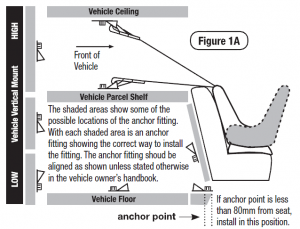

CAUTION: DO NOT OVERTIGHTEN ATTACHMENT BOLT. MAXIMUM TORQUE IS 20NM.
WARNING: If A.D.R. anchorage point is recessed, spacer(s) may be required. Spacer Part No’s are as follows: 10mm – CCS001; 5mm – CCS002
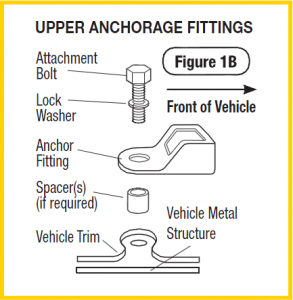

UPPER ANCHORAGE FITTINGS
For cars not fitted with a child restraint anchorage point
For Sedans OnlyDrill a 9mm diameter hole in the parcel shelf on the centre line of the seating position as shown in Figure 1C. Hole must be no closer than 200mm from the front of the back seat. Install the anchor bolt as shown in Figure 1D.
Note to Queensland purchases: The installation of anchorage points must be approved by authorised officers appointed by Queensland Transport. Authorised officers can be sourced from all Queensland Transport Customer Service and Queensland Ambulance Service Centres.
For Vehicles other than Sedans In Australia, consult your nearest child restraint fitting station of traffic authority for vehicle inspection to find the best, correct position for the placement of the anchorage point, and for the correct attachment bolt length use of spacers.In New Zealand consult the agent of the vehicle.




![]()
![]()
![]()
![]()
![]()
CHILD RESTRAINTS MUST NOT BE ATTACHED TO UNSOUND METAL OR WOOD OR SYNTHETIC STRUCTURES. WHEN DRILLING THE 9MM HOLE DO NOT DRILL THROUGH FUEL LINES, FUEL TANKS, ELECTRICAL WIRING OR RADIO SPEAKERS. WEBBING STRAPS MUST BE PROTECTED FROM SHARP CORNERS AND EDGES.
THE ANCHOR FITTING MUST BE USED ONLY AS DESCRIBED ABOVE. IT MUST NOT BE HOOKED ONTO ANY OTHER OBJECT.
Insurers InformationIf your restraint has been involved in a severe crash, you should destroy the restraint even if no damage is obvious. Some insurance companies offer vehicle insurance which covers or partially covers the replacement of your child restraint. Contact your insurance company for further details. Your insurance company may require you to keep the child restraint for assessment, but do not use the child restraint after a severe crash. To assist you in making an accident insurance claim cut the following statement and include it with your claim.
NOTICE TO INSURANCE COMPANY CHILD RESTRAINT INVOLVED IN AN ACCIDENT
All InfaSecure child restraints are manufactured to Australian/New Zealand Standards AS/NZS1754 which requires us to advise users of child restraints to “Destroy the entire restraint if it has been in use in a severe crash, even if no damage is obvious”. The Australian/New Zealand Standards committee, advise that this statement applies whether a child was in the child restraint or not. We consider a “severe crash” as being one where the main body structure of the vehicle is distorted. There is no method of determining if the restraint has been damaged and we concur with the Australian/New Zealand Standards in recommending destruction of the child restraint. This notice is to advise you of the requirements of the Australian/New Zealand Standards and our obligation in complying with the standards.Please assist the owner of this restraint in their claim.INFASECURE PTY LTD ABN: 52 149 173 660 Head Office and Registered Address 110-114 Old Bathurst Rd, Emu Plains, NSW 2750 P.O. Box 487, Emu Plains, NSW 2750 Head Office P: 02 4728 8000 F: 02 4728 8040 www.infasecure.com.au
LIFETIME WARRANTYON SUPER STRONG BLOW MOULDED SHELL PRODUCTSRegister your product to receive lifetime warranty*, product updates and information.! Please visit infasecure.com.au/warranty-registration to register your product.InfaSecure Warranty InfaSecure Pty Ltd warrants this product for twelve months from the date of purchase against failure due to manufacturing faults or faulty materials. Misuse, accidental damages, normal wear and tear are not covered by this warranty. When used for commercial use the period is limited to six months. “Our goods come with guarantees that cannot be excluded under the Australian Consumer Law. You are entitled to a replacement or refund for a major failure and for compensation for any other reasonably foreseeable loss or damage. You are also entitled to have the goods repaired or replaced if the goods fail to be of acceptable quality and the failure does not amount to a major failure.” Additional Warranty on Blow Moulded Child Restraints Our blow moulded child restraints are covered against faulty materials and manufacturing when used under normal conditions and according to the instructions. In the unlikely case that you do have a fault in relation to material quality or manufacturing that restricts your ability to use your Child Restraint normally, we will repair or replace the product within the following warranty periods from date of purchase:
- 12 month warranty for material and fabrics
- 2 year warranty for straps and webbing
- 5 year warranty for hardware and fittings
- Lifetime warranty* on the manufacturing of the seat moulding
Please read your instruction manual carefully before using any of our products. The above express warranties do not apply where a failure or defect results from improper care, misuse or from normal wear and tear. Refer to website for more details: www.infasecure.com.au*Lifetime warranty refers to the life span of the seat which is 10 years from the Date of Purchase.26
We are proud to be working with The Wiggles. With their help, we are able to reach more young families with much needed information” ” and advice to keep our little ones safe.
INFASECURE PTY LTD ABN: 52 149 173 660Head Office and Registered Address 110-114 Old Bathurst Rd, Emu Plains, NSW 2750 P.O. Box 487, Emu Plains, NSW 2750
HEAD OFFICEPhone No: +61 2 4728 8000 Fax No: +61 2 4728 8040 Email:
CUSTOMER SERVICEPhone No: +61 2 4728 8090 Fax No: +61 2 4728 8040 Email:
ISSUE: D
References
[xyz-ips snippet=”download-snippet”]



